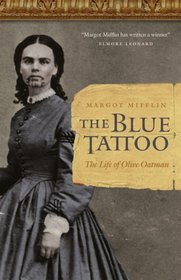Helpful Score: 3
This is an account of a young girl, Olive Oatman, who was abducted by the Indian tribe who murdered her family. She was later traded to another tribe. Initially,the story kept me reading with many teaching moments concerning the Indian tribes Oatman lived with. As I read further the author spent a lot of time commenting on the Methodist minister who wrote a book about Oatman. Mifflin pointed out the many inaccuracies the man made in his writing as she corrected the misinformation. This got a little old as it seemed to dominate the content at times. Overall,I did find the book interesting and informative.
Helpful Score: 1
This was a very interesting and compelling telling of the life of Olive Oatman. In the early 1850s, Olive was a pioneer girl heading west with her family on a wagon train with a splinter group of Mormons called the âBrewsteritesâ, a group headed by James Colin Brewster, who broke off from Joseph Smith's church and who thought Eden was waiting for them at the mouth of the Colorado River. (I was brought up in the Mormon Church in Utah and I had never heard of this group). Her father was anxious to get to the "promised land" and did not heed the advice of others to stay together. He pushed on with his family and got stranded resulting in a massacre by the Yavapai Indians in Northern Mexico. Olive's family were all killed with the exception of her and her younger sister, Mary Ann and one brother, Lorenzo, who managed to escape. Olive and Mary Ann were taken into captivity and made slaves by the Yavapais. After one year, they were traded to the Mohave tribe where they were well cared for. But being assimilated into the tribe meant getting tattooed on the chin, a practice all women in the tribe underwent. Mary Ann died of an illness after two years but Olive ended up being ransomed and returned to white civilization after five years with the Mohave.
Olive's story was sensationalized after her release especially through a book titled Captivity of the Oatman Girls which was ghost written by Royal B. Stratton, a Methodist minister who befriended the Oatmans after Olive's release. His book consisted of narration by both Olive and Lorenzo with an introduction and commentary by Stratton. Stratton omitted, exaggerated, and fabricated information in order to deliver a title that was at once pious and titillating for his publisher. His account differs significantly from Olive's first interviews and even though she was treated well by the Mohaves, Stratton tried to make the Indians look savage and it was essentially a racist narrative against them. So his book really needs to be read with a wary eye for untruths.
Mifflin tries to get to the truth behind the Olive Oatman story in The Blue Tattoo. She did a lot of research using historical documents and letters. She includes what happened to Olive in later years including her marriage and lecture tours where she seems to have made the Indians look like savages even though she was well-treated by them. Overall, I did really find this interesting reading. It provides a lot of historical information related to the Southwest and also includes information about the attitudes of time such as how many abolitionists thought of Native Americans as savages and should be contained or eliminated while at the same time wanting to abolish slavery. She also includes information on early examples of tattooing and how Olive's story has been dramatized and written about down through the years.
Olive's story was sensationalized after her release especially through a book titled Captivity of the Oatman Girls which was ghost written by Royal B. Stratton, a Methodist minister who befriended the Oatmans after Olive's release. His book consisted of narration by both Olive and Lorenzo with an introduction and commentary by Stratton. Stratton omitted, exaggerated, and fabricated information in order to deliver a title that was at once pious and titillating for his publisher. His account differs significantly from Olive's first interviews and even though she was treated well by the Mohaves, Stratton tried to make the Indians look savage and it was essentially a racist narrative against them. So his book really needs to be read with a wary eye for untruths.
Mifflin tries to get to the truth behind the Olive Oatman story in The Blue Tattoo. She did a lot of research using historical documents and letters. She includes what happened to Olive in later years including her marriage and lecture tours where she seems to have made the Indians look like savages even though she was well-treated by them. Overall, I did really find this interesting reading. It provides a lot of historical information related to the Southwest and also includes information about the attitudes of time such as how many abolitionists thought of Native Americans as savages and should be contained or eliminated while at the same time wanting to abolish slavery. She also includes information on early examples of tattooing and how Olive's story has been dramatized and written about down through the years.
Suzanne L. reviewed The Blue Tattoo: The Life of Olive Oatman (Women in the West) on + 9 more book reviews
This book is a true story of a young girl traveling west with her family in 1851.




